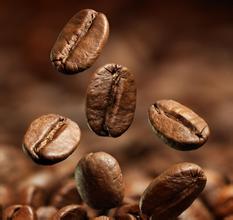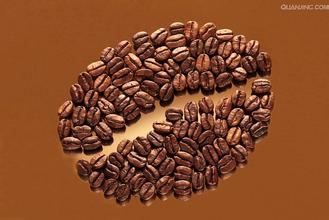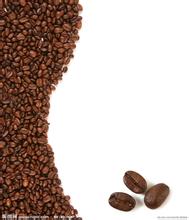How to brew coffee beans the process from coffee beans to coffee
Coffee bean roasting is a process in which raw beans are converted into sugars and acids by means of specific equipment at high temperature. in this process, substances such as cellulose will be carbonized to varying degrees, water and carbon dioxide will be volatilized, and the protein will be converted into enzymes, which combine with the rest of the fat to form an oil film on the surface of the coffee, and the coffee bean itself will expand by baking. Pores are created inside. Roasted coffee beans can produce special aromas and different flavors before they can be used to brew coffee.
Coffee bean roasting is a complicated processing technology, which is quite professional. If you want to make delicious coffee beans, you need perfect equipment and high coffee roasting technology, so unless it is for personal pleasure, it is generally not suitable for family.
With the size of the baking firepower, the length of time, coffee beans will show different depth and taste changes. Different characteristics of coffee beans, different drinking methods determine the depth of roasting of coffee beans. Generally speaking, the roasting degree is light, the coffee bean color will be light brown, the sour taste is strong, and the baking degree is deep, the hue is dark, and the bitterness is enhanced. Traditionally, the roasting of coffee beans is divided into eight different degrees:
The lightest baking (Light)-slightly yellowish coffee color, not very strong aroma and flavor
Light roasting (Cinnamon)-cinnamon color, slightly better flavor, a kind of American coffee
Ordinary roasting (Medium)-maroon, mellow, moderately sour, a kind of American coffee
Medium baking (High)-A slightly thicker baking method than shallow baking, with bitter acid and good aroma and flavor.
Medium and deep roasting (City)-the word City- comes from New York City and is a standard roasting method suitable for Colombian and New York-style coffee
Strong roasting (Full City)-no sour but bitter, suitable for iced coffee
Strong roasting (French)-French, also known as European style, due to the strong degree of baking, coffee beans fat oozing surface, dark color, strong bitterness, with a unique flavor
The strongest roasting (Italian), also known as Italian style, has a strong roasting degree, and the coffee beans are carbonized black, scorched and without aroma, so they are suitable for brewing Italian steam coffee.
Third, storage:
1. Raw beans:
The raw coffee beans before stir-frying are only for the convenience of transshipment, without special packaging conditions, depending on the different production areas.
For economic and practical considerations, it is generally packed in 60 kg gunny bags and further processed after arriving at the destination. Of course, there will be some different packaging, such as Jamaica Blue Mountain is packed in 70kg wooden barrels.
2. Cooked beans:
Roasted coffee beans are easy to oxidize with oxygen in the air, making the aroma volatilized, the oil quality deteriorated, and the smell of decay. How to maintain the aroma of coffee and prevent the deterioration caused by external temperature, humidity and light is the main task of coffee bean storage.
In addition, because coffee beans produce a considerable amount of carbon dioxide gas after roasting, and carbon dioxide also reduces the aroma of coffee, the packaging of cooked coffee beans should not only avoid contact with the air, but also try to remove carbon dioxide from coffee beans. At present, there are several commonly used packaging methods of coffee beans.

Important Notice :
前街咖啡 FrontStreet Coffee has moved to new addredd:
FrontStreet Coffee Address: 315,Donghua East Road,GuangZhou
Tel:020 38364473
- Prev

How to make coffee beans
To do the correct grinding according to the coffee machine used, grinding can be roughly divided into three stages: rough grinding, medium grinding, and fine grinding. Coarse ground coffee is suitable for filter coffee pot (traditional American brewer), medium ground coffee is suitable for follicular, flannel filter and siphon coffee pot, and fine grinding is most suitable for coffee distiller (also known as water drop coffee maker).
- Next

Italian steamed coffee mechanical picking and manual picking of coffee beans
The processing methods from coffee fruit to coffee beans can be roughly classified as dry processing and wet processing. Dry processing: the coffee fruit is dried and dehydrated by natural conditions such as sunlight and ventilation, and then the dried coffee fruit is put into the peeled pulp, peel and silver skin. This method is the most economical and traditional processing method, and the coffee beans treated by this method can maintain their fragrance for a long time.
Related
- Does Rose Summer choose Blue, Green or Red? Detailed explanation of Rose Summer Coffee plots and Classification in Panamanian Jade Manor
- What is the difference between the origin, producing area, processing plant, cooperative and manor of coffee beans?
- How fine does the espresso powder fit? how to grind the espresso?
- Sca coffee roasting degree color card coffee roasting degree 8 roasting color values what do you mean?
- The practice of lattes: how to make lattes at home
- Introduction to Indonesian Fine Coffee beans-- Java Coffee producing area of Indonesian Arabica Coffee
- How much will the flavor of light and medium roasted rose summer be expressed? What baking level is rose summer suitable for?
- Introduction to the characteristics of washing, sun-drying or wet-planing coffee commonly used in Mantenin, Indonesia
- Price characteristics of Arabica Coffee Bean Starbucks introduction to Manning Coffee Bean Taste producing area Variety Manor
- What is the authentic Yega flavor? What are the flavor characteristics of the really excellent Yejasuffi coffee beans?

